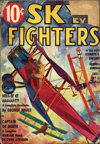Eugene M. Frandzen painted the covers of Sky Fighters from its first issue in 1932 until he moved on from the pulps in 1939. At this point in the run, the covers were about the planes featured on the cover more than the story depicted. Mr. Frandzen features the trusty Sopwith 1½ Strutter whose pilot has been injured in a battle with a couple of German Rumpler C1’s on the January 1936 cover!
The Ships on the Cover
THE British Sopwith 1½ Strutter was  one of those ships that rated so high early in the war that all the Allied governments were scrambling to get them for their own air forces. T.O.M. Sopwith began making planes that did things back in 1912. His seaplane scout won the Schneider Cup at Monoca. His “Bat boat” was so good that the Germans bought them before the war.
one of those ships that rated so high early in the war that all the Allied governments were scrambling to get them for their own air forces. T.O.M. Sopwith began making planes that did things back in 1912. His seaplane scout won the Schneider Cup at Monoca. His “Bat boat” was so good that the Germans bought them before the war.
The amphibian “bat boat” had wheels which could be raised or lowered long before the days of modern retractable landing gear. Then came the Sop Tabloid which so revolutionized airplane design in 1913 that it became the grandpa of all fighting scout machines of the war. All the best features of former Sopwith models had been incorporated in the Tabloid.

In 1915 the Sop 1½ Strutters came out with the goods. They carried a synchronized gun firing through the propeller. The gun and the plane were a Sopwith team as the Sopwith Aviation Co. developed the synchronization gear which made the teamwork possible. The 1½ Strutter was a two-seater, although they manufactured a singe seat version later.
The name 1½ Strutter came from the peculiar bracing job. The top wing was in two parts joined to a center section. To support these, short struts ran from the top of the fuselage at an angle to quite a distance out on the top wing.
Another Two-Seater
The Rumpler C1 was a two-seater also. It wasn’t much of an original idea in design as it was so directly related to the old Taube which the Rumpler Co. had manufactured under license from its originator, the Austrian Etrich. The C1 had the backswept fish-like tail of the Taube monoplanes. An exposed radiator hung in the breezes at the center part of the leading edge of the top wing.

One day back in 1916 these two-seaters, the Sop and the Rumpler got in a scrap. That is where we find them on the cover. Two Rumplers have ganged up on the Sop, which wouldn’t place the 1½ Strutter in such a bad position as it was a much superior ship and welcomed a chance to show off to the challenging Germans. The Britishers were cocky and allowed the German observer to get in a burst.
The pilot of the land 1½ Strutter suddenly groaned in an agonized breath. The observer busy swinging his Lewis on the German ship couldn’t hear the startled cry from the front pit. The ship lurched and nearly threw the amazed gunner from his cockpit. He turned his head. “What the—” he shouted and was suddenly silent. The pilot was bent over the instrument panel. With no dual controls the ship seemed doomed. There was only one thing to do.
“Hold Her Steady!”
The observer shouted “Hold her steady!” He swung out of his pit and muscled slowly up over the turtleback and grabbed a center section strut as the ship shuddered from the enemy’s fire. It rocked and swayed dangerously. Holding onto the fuselage the observer got on the left wing and inched his way to his comrade’s side. German bullets had put both the plucky pilot’s arms out of commission. He was trying to fly the plane with his legs and feet alone. His face was chalk-like, his teeth clamped tight in pain. The observer grabbed the stick and pulled up the nose. Then, as the Rumplers came in for the kill, their guns churning a drizzle of slugs into the Allied ship, he shoved the slick against the firewall. The Sop nosed over.
As the gap widened between the diving Sop and the surprised German pilots, the British anti-aircraft gunners on the ground below who had been waiting for just such a break smacked upward a curtain of screaming steel. The Rumplers’ pilots quickly turned back across their own lines.
The 1½ Strutter pulled drunkenly out 
of her dive, wobbled and did a bellyflop 
in an abandoned potato patch behind the 
lines. It took two to land her, a pilot and 
a backseat driver who said little but did
much.

Sky Fighters, January 1936 by Eugene M. Frandzen
(The Ships on The Cover Page)









